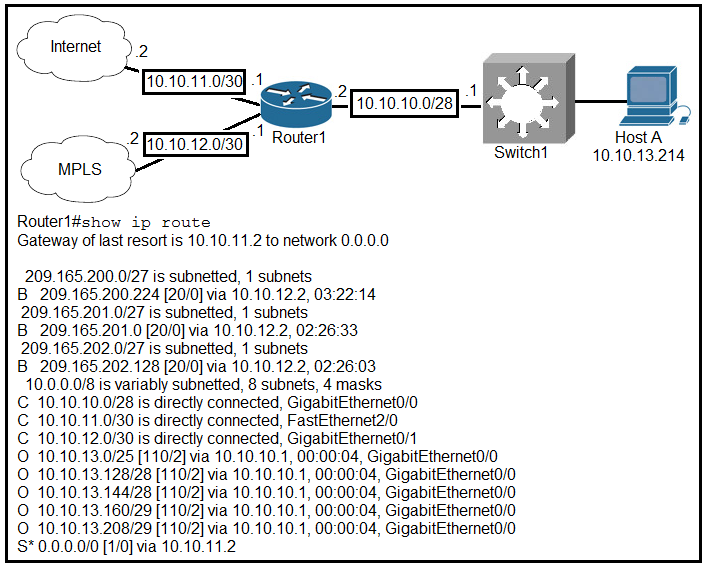
Refer to the exhibit. What is the subnet mask of the route to the 10.10.13.160 prefix?

Refer to the exhibit. What is the subnet mask of the route to the 10.10.13.160 prefix?
The subnet mask of the route to the 10.10.13.160 prefix is 255.255.255.248. This corresponds to a /29 subnet, which is evident from the routing table entry indicating a /29 mask. This is the correct subnet mask for that specific route.
D THE DESTINATION IS THE NETWORK 10.10.13.160 WITH MASK /29 WHICH IS THE ANSWER D. THE OTHER ROUTES DO NOT COVER THE NETWORK.160
They are trying to trick us. Of course a /29 = 255.255.255.248. But the question: "What is the subnet mask of the route to the 10.10.13.160 prefix?" ...key word is ROUTE. It is not asking what is the mask of the 10.10.13.160 /29. There is a ROUTE to that subnet, and it is asking for the mask of that ROUTE. The ROUTE is 10.10.10.1 (the IP of g0/0), and that IP is part of the 10.10.10.0 /28 network. And we all know that a /28 mask is 255.255.255.240. Therefore the correct answer is A.
I strongly dislike how Cisco insists on us divining such complex meanings from their questions. It defeats the point of a technical examination when half of the questions require such deep examination. With that said, I disagree. 10.10.10.1 is *not* the IP of g0/0; it's the IP of the next hop. 10.10.10.0/28 is the subnet connected to g0/0; the route for the 10.10.13.160 prefix is recursive, and resolves to the interface on which that subnet is connected. A *prefix* is just another word for a subnet, so the question is really asking what is the mask of the route to 10.10.13.160 subnet is. The *route* is the entry in the routing table, not the next hop, or the subnet address on which the next hop resides. It must therefore be D.
A host route is still a route. Highest prefix wins. So D for me
- Analyzing the subnet: 10.10.13.144/28 - Last octet: .144 = 1001/0000 - Range of addresses in this subnet: 10.10.13.144/28 ... 10.10.13.159/29 - So, 10.10.13.144/28 never reaches to the 10.10.13.60 route.
The answer just has to be D. Certbuster reflects my sentiments fully....... If you have to spend 3 minuted understanding what the question is trying to ask due to CISCO preferring to present questions in a foreign language the test needs to be a whole lot longer than 2 hours, thats without factoring in the 'sims' these days... DDDDDDDDD
The given answer is correct; stop searching for the 'squaring of the circle.' It doesn't have such a philosophical interpretation as some are making it out to be. The correct answer is D.
the question is: ¿what is the "subnet mask"? so, The subnet mask for a /29 block is 255.255.255.248 correct answer: D
/29 ans is D
D = correct
/29 is 255.255.255.248 or /5 in the last octet, which is 11111000, which is 248.
D is correct
It´s A for me
Given answer is correct
THe route is the record ""O 1010.13.160/29 [110/2] via 10.10.10.1...", It's not specific to the ip of next hop. So the network mask of the route is 29.
So many wrong answers in the comments
f$ck this DUMP! lol. another question wrong....... i dont know. if anyone try the ccna 200-301 only for this dump questions, you spend your money!
Mate, count carefully: /29 translates to 11111111.11111111.11111111.11111000, which is 255.255.255.248 because it's 128+64+32+16+8, totaling 248
The answer is D
The correct answer is A, because the route for the prefix 10.10.13.160/29 is 10.10.10.0/28. Please you can't argue that 10.10.13.160 is the route , because this is not the route this is destination prefix, therefore the next ho is "the route" , in layman terms a path to reach 10.10.13.160/29 network. Therefore the mask for the route is that of 28 bits long, that is 255.255.255.240.